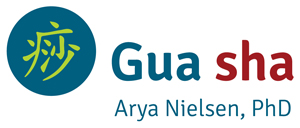Gua sha is used whenever a patient has pain in any acute or chronic disorder. There may be aching, tenderness and/or a knotty feeling in the muscles. Palpation reveals sha when normal finger pressure on a patient's skin causes blanching that is slow to fade. In addition to resolving musculo skeletal pain, Gua Sha is used to treat as well as prevent common cold, flu, bronchitis, asthma, as well as any chronic disorder involving pain or inflammation.
Gua sha can be done almost anywhere on the body but is typically applied at the back, neck, shoulders, chest, abdomen, buttocks and limbs. Gua sha is also applied over the joints but not without first treating the channels that supply a joint area.
The area to be treated is lubricated with oil or balm*. The area to be treated is press-stroked in one direction with a round-edged instrument until the petechiae are completely raised. Exactly how to safely apply Gua sha, to whom and when is learned from a teacher of Gua sha. (insert image of press stroking)
Thick oils such as peanut oil were used as a lubricant in China. For 2 decades I recommended using Vick's Vapo-rub because patients are familiar with its smell, and Vicks can still be used in a pinch. Still, because Vicks is a petroleum based product, I now recommend Badger balm*. FYI Tiger Balm is not appropriate for Gua sha as it is too spicy.
*Badger Balm is a vegetable-based line of products with mostly organic ingredients. Consult www.Badgerbalm.com
A soupspoon, coin, slice of water buffalo horn or jade are used in Asia. I have found that a simple metal cap with a rounded lip works best and is by far more comfortable to the patient. Moreover, it can be disposed of after one use, eliminating risk of transfer of blood borne pathogens to another person. (small image of tool)
The color of the Sha is both diagnostic and prognostic. A practitioner trained in Gua sha notes the color of the sha, its quality and how fast it fades in making a ‘diagnosis’, that is, in assessing the location, quality, mutability and pattern of a presenting problem.
The Sha petechiae should fade in 2-4 days. If it is slower to fade, indicating poor Blood circulation, the practitioner must ascertain whether it is deficiency of Blood, Qi or Yang, a deeper stagnation or organ deficiency at the root. (insert image 2 day old sha)
In most cases the patient feels an immediate shift in their condition particularly in their pain or sense of constraint, range of motion. In traditional medicine, Gua Sha moves stuck Qi and Blood, releasing the Exterior, mimicking sweating and moving Fluids.
Modern research has confirmed Gua sha reduces pain, inflammation while stimulating an immune protective response that can persist for days following treatment. Gua sha is a valuable treatment for musculoskeletal problems as well as internal organ conditions including respiratory and hepatic inflammation.
Gua sha is safe when done by someone properly trained, and it is serious medicine. Knowing when to use it and what to expect from treatment is as important as good technique. Because Gua sha lifts cells out of the vascula and some of those cells may express from the skin, a practitioner of Gua sha must respect guidelines of safety to eliminate risk of exposure to blood borne pathogens. Click here for safety information.
It is also recommended to moderate activity after treatment, even rest. After treatment: no drugs, booze, sex, fasting, feasting or hard labor, including working out, for the rest of the day. In other words: chill out, mellow mode, middle way, relax; let the treatment work.
First: read the book! It has the history, research and physiology detailed as well as how to apply, what to expect and over 50 clinical cases.
The Gua sha DVD demonstrates basics of the Gua sha technique on real patients.
Sign up for the Gua sha Certification Course. Online lectures and direct hands on training with Dr. Nielsen part of the training to be certified in Gua sha.
The book is available in English, German and French. The DVD is available in English and German.



